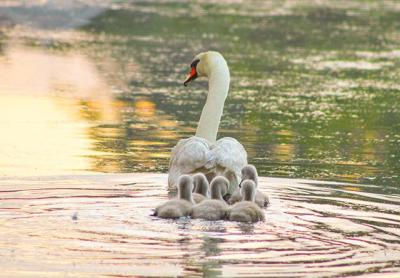Nature Notes: Speak Up for Mute Swans

“Here we go again,” as Mel Allen used to say, when the Yankees were homering the opposition to death. This time it’s not about baseball but about swans, mute swans.
The New York State Department of Environmental Conservation and Gov. Andrew M. Cuomo are back on the bandwagon and the bandwagon is out to eliminate once and for all Cygnus olor from New York State waters. Their reasons: It scares people kayaking and canoeing, it picks on native ducks and geese, it befouls the water, and threatens swimmers and walkers along pond shores and rivers.
Hokum, hokum, hokum. While the state is so intent on doing away with a creature as elegant as the mute swan, which has been here since the 1880s, I don’t see it doing a thing about the other interlopers: mallard ducks, starlings, house finches, parakeets, great black-backed gulls, carp, Italian wall lizards, house sparrows, cattle egrets, and many more. The list goes on and on.
Most of the state’s mute swans are here on Long Island. Why aren’t the Island’s various Audubon clubs solidly taking up the state’s hue and cry? Because they know better than the bureaucrats who govern our fish and wildlife and make up the silly rules concerning them in order to stay on the payroll and keep the ruling politicians on their side. Are mute swans really that evil that they deserve to be erased from the state’s flora and fauna lists?
Take Canada geese, for instance. They aren’t native, are they? They outnumber the local duck species, they crap on golf courses and public open spaces. Shall we eliminate them, too? How about the national birds, the bald eagles, that are beginning to nest on Long Island after a long absence? They rob ospreys of their catches and steal their young if the osprey’s nest is left unguarded. Shall we do them in before they really get out of hand? Are the native white-tailed deer really the number-one culprits behind the spread of tick diseases? If you do away with all of the deer will Lyme disease, ehrlichiosis, and babesiosis go away? Not really.
The D.E.C. and other state conservation departments have a spotty past with respect to what is allowed to stay, what goes, and what should be hunted to excess. After all, the D.E.C. is that same department that introduced various foreign plants, say, the Japanese pine, the Russian olive, and several others from out of the country in the interest of re-landscaping dunes and other “barren” formations on Long Island.
How did grass carp get established in parts of the United States? How did the non-native multiflora rose become such a nuisance in our wooded ecotones? Why did the foreign reed subspecies of Phragmites australis take over our marshes and other spots to the chagrin of the our native Phragmites subspecies, which has become very rare and probably completely extirpated from New York State, including all of Long Island?
How did West Coast salmon species get into our Great Lakes in the late 1900s? Yes, you guessed it, they were introduced on purpose. The fish crow from the south is becoming a nuisance in our upper East Coast villages and cities. Shall we outlaw it, as well?
The list of malfeasances and counter-malfeasances is extensive.
But, before we do them in because of a few bad acts in the past, let’s also defend the D.E.C. and its sister organizations around the country for all the good they do and have done. There was once a time when we filled in or ditched wetlands for this or that reason: mosquito control, drainage, building, and the like. Wetlands are now almost universally protected in New York State and throughout the rest of the United States. The California condor was down to fewer than 20 individuals; now it is making a superlative comeback because of the efforts of the United States Fish and Wildlife Service and California Fish and Game. Similarly, the whooping crane was almost gone but it is slowly increasing its numbers in the west.
Hawks of all kinds were once shot on sight. Now in New York and most other states they are completely protected. In the last 20 years peregrine falcons, sharp-shinned hawks, and Cooper’s hawks have returned to breed on Long Island, and now the bald eagle has joined them. And just this month, the state banned the taking of diamondback terrapins, those turtles that inhabit our estuarine waters and come ashore to breed on coastal uplands every June and July.
On the other hand, the state and federal agencies that have been largely responsible for the return of this or that almost extinct species and considerable habitat protection, could not have done it alone. They needed help and support from volunteer private individuals, private clubs and the many not-for-profit organizations such as the Nature Conservancy, the Sierra Club, the various bluebird clubs, Ducks Unlimited, the Natural Resources Defense Council, Greenpeace, Friends of the Earth, the National Parks Conservation Association, the American Littoral Society, the Audubon Society, the American Forestry Association, the Garden Club of America, and so many more left unnamed.
But in this case, most of those organizations are not for sticking it to the mute swan the way New York State is planning on doing. Governor Cuomo, I beg of you, please don’t pick on the swans. They were here in America before you and all the rest of us humans alive today. They’ve survived through various epidemics, they tend to be monogamous, they protect and train their young the way we humans do. In other words, they are almost perfect models for us to follow, not to obliterate. The majority of Long Islanders and upstate New Yorkers like them. Enough said.
Larry Penny can be reached via email at [email protected].
